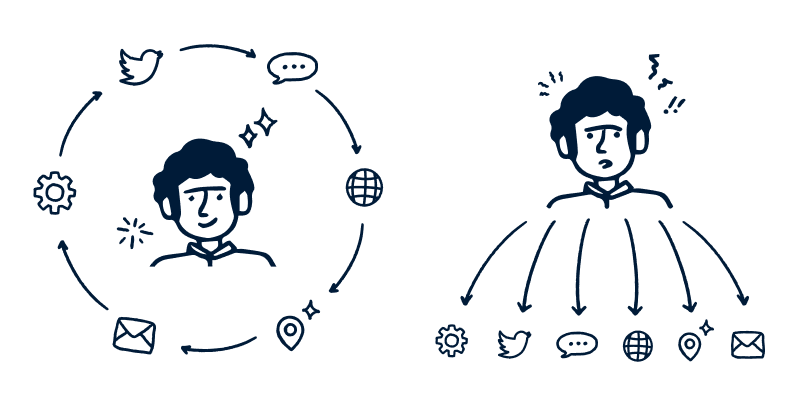In today’s increasingly digital environment, it’s more important than ever to meet your customers where they are and communicate with them in the channels they prefer.
Since customers can interact with businesses in so many different ways such as phone call, SMS, social media, in-store, or live chat companies that nail an omnichannel customer service can create steadfast fans with a seamless customer experience.
This article will teach you the essentials of omnichannel customer service with examples of brands who get it right, and then show you different ways it could look like for your own.
What is omnichannel customer service?
Omnichannel customer service is a strategy that aims to provide seamless and integrated customer support across multiple channels and touchpoints, such as phone, email, social media, live chat, SMS, and in-person interactions.
Integrating all these channels in one place provides consistent and personalized interactions, while being proactive and responsive to customer needs for enhanced satisfaction, loyalty, and retention.
While omnichannel customer service is becoming increasingly prevalent in the support world, it’s often conflated with multichannel customer service. So what’s the difference between omnichannel and multichannel customer service?
What is multichannel customer service?
Multichannel customer service is a versatile approach that ensures businesses can connect with customers across various communication channels like email, chat, social media, and more. Just like with omnichannel customer service, this means that customers have the flexibility to choose the channel that suits them best, while businesses can provide support through multiple avenues. However, multichannel customer service happens across multiple applications or systems that are usually not connected with one another. In other words, a support agent may have multiple tabs and/or windows open on their computer to field messages from customers across different channels.
Omnichannel vs multichannel customer service

Omnichannel customer service involves a cohesive, seamless, unified customer communication experience, where every channel a customer might contact you through is integrated into a single platform. Multichannel customer service means fielding customer communication from different places but not necessarily offering a unified and seamless experience.
Omnichannel service allows support reps to easily transition between conversations without losing anything in the shuffle. Multichannel might require switching between tabs and windows, copy-and-pasting important customer context, etc.
Essentially, omnichannel and multichannel customer service are two different approaches to providing support and engagement to customers through multiple communication channels. Here’s a deeper comparison between the two:
Channel integration
Omnichannel customer service integrates all online and offline channels, aggregating customer data and interactions in one place to provide a unified view of customer interactions, regardless of the channel used. For the business, having a birdseye view of the customer enables the support agent to have the full picture and easily pick up the conversation wherever it left off. For the consumer, it creates a delightful customer experience that’s not only convenient but impressive. Amazon does a great job of this. The other day I bought some baking supplies online at Amazon, got a text alerting me that it was out for delivery, picked up a phone call from the driver that it had arrived, and then received a follow-up email asking for my review of the product. Talk about seamless!
In multichannel customer service, each channel operates more standalone, and interactions on one channel may not be connected to interactions on another channel. This creates extra work for the support agent who must check each channel to follow up with customers, while also needing to string together the various customer inputs to get the full story. On the flip side, the customer experience is less than ideal if the customer constantly needs to repeat themselves about things they’ve already communicated before. For example, if the customer asks a question through a chatbot but then decides to follow up on the phone, they might feel frustrated if they’re repeating what they already told the chatbot to the human agent answering the phone. Sound familiar?
Consistency and cohesion
Omnichannel customer service provides a consistent and cohesive experience across all channels, with a focus on delivering a seamless customer experience regardless of the channel used. Multichannel customer service, on the other hand, may result in potential inconsistencies and gaps in customer service, as interactions on different channels may not be coordinated or integrated.
If your service is inconsistent across channels, it can create a jarring experience for the customer. For example, you might be known for fast response times over email, but if a customer reaches out to you on social media, they should have a relatively similar experience. Setting service level agreements (SLAs) is a good way to ensure your customers hear back from you in a timely manner.
Data and insights
Omnichannel customer service allows for better data collection and analysis, as customer interactions and data are collected into one place, providing businesses with a comprehensive view of customer preferences, behaviors, and needs. Multichannel customer service may result in scattered data across different channels, making it harder to gain holistic insights.
Benefits of omnichannel customer service
An omnichannel communication strategy presents a ton of benefits for your business. Here’s a handful:
Enhanced customer experience and satisfaction: Providing a seamless and consistent experience across various channels makes it easier for customers to interact and engage with you, empowers your support reps to be fully informed while communicating with customers, and leaves everyone happier. This leads to faster response times, higher customer satisfaction scores like CSAT and NPS, and better customer retention.
Seamless customer interactions across various channels: Omnichannel customer service enables customers to switch between channels without losing the context of their interactions. This can save customers time and effort and contribute to a more positive perception of the business.
Increased operational efficiency and effectiveness: Omnichannel customer service allows for a centralized approach to managing customer interactions, which can result in increased operational efficiency and effectiveness. Businesses can streamline their processes, reduce duplicated effort, and optimize resource allocation, leading to cost savings and improved productivity.
Enhanced data collection and analysis for customer insights: With omnichannel customer service, businesses can collect and analyze customer data from various channels, providing valuable insights into customer preferences, behaviors, and needs. This data can inform business decisions, enable targeted marketing efforts, and help improve products and services based on customer feedback.
How to implement an omnichannel customer service strategy
Implementing an effective omnichannel customer service strategy requires attention to key elements.
Ensure that you have consistency in branding, tone, and messaging across all channels to maintain a cohesive customer experience.
Prioritize personalization and contextualization of customer interactions to create meaningful connections with customers and make them feel valued.
Commit to continuous improvement and optimization based on customer feedback so you’re constantly refining your omnichannel customer service strategy
Invest in an omnichannel customer communication platform like Front. Front is a new way to route, respond to, and measure all your customer conversations. We’re an omnichannel hub for meeting customers where they are, allowing you to manage all your communication channels in a single platform: email, SMS, voice, live chat, social media, and more.
Think Front could be a good fit for your team? Get started here.
Written by Andrea Lean

